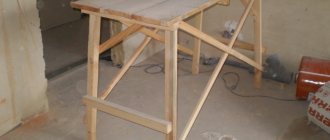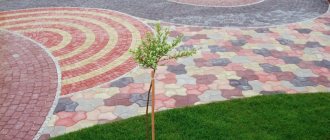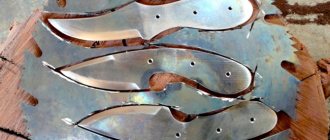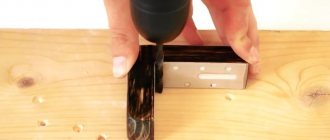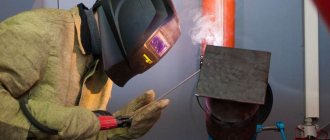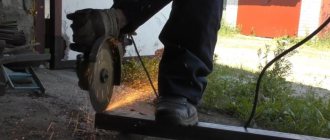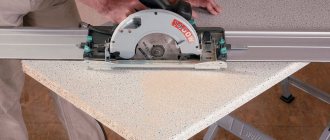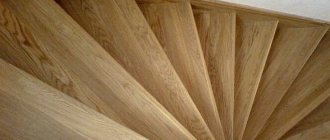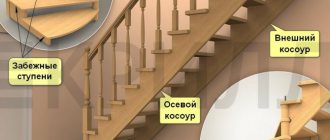Washed down the tiles at 45 degrees
Today, a fashionable trend is to design corners without using plastic corners; to do this, cut the tiles at 45 degrees - yourself .
This type of cutting can have different names: · Burring.
· Kremlin corner .
· Pruning.
· Sharpening.
All these names have one concept - cutting tiles at 45 degrees. Looking ahead, I would like to draw attention to the advantages and disadvantages of this method of framing a corner .
Video: How to Cut with a Circular Saw at 45 Degrees
When purchasing, be sure to pay attention to such an indicator as the depth of the saw
Note. The cutting depth of the saw blade ranges from 30 to 130 mm.
You need to know what thick boards you need to work with. The choice of saw is also very important. For a neat cut, a disc with a large number of teeth is suitable. If the disc has sparse teeth, the cut will be faster, but the cut will be rougher.
Sections with such a saw are usually smooth and practically free of chips
How to make a 45 degree cut?
This angle is found in the manufacture of various products. Let's start cutting. First, the saw blade moves ninety degrees. Depending on the model, there is a red bolt on the side that needs to be unscrewed.
The soleplate is then rotated to a 45 degree angle and secures the bolt back. Take a piece of chipboard as a blank. We secure it with clamps to the table top so that the part is cut out of the table.
After setting the line. It is usually included with the circular saw. The saws have 2 marks zero and 45. We will cut 30 millimeters, for which we combine three on a line with a mark of forty-five on the sole. Then tighten the screw that secures the ruler.
Next, the sole should be positioned so that the ruler rests on the edge of the workpiece. The saw starts and, after it is completely unwound, presses the ruler firmly against the edge of the workpiece and moves forward.
Seeing advice
If you cut the edges with a chip, you should do the following:
- Take a small sheet of 6 mm fiberboard.
- Glue this sheet to the base using adhesive tape.
- With the saw running, we plunge the blade into the rigid board to create a recess with zero clearance.
Accurate cutting pattern
How to make a cut? The device was made with a slight fit, after pressing the circular stop we sawed off the edge of the base to the desired length. The saw blade defines the cutting line for the circular saw.
The board is marked instead of a saw. Pressed with a lower accent to match the board, the edge is aligned. By having the saw go through the device first, cutting boards are more precise.
Make a straight cut using a circular saw
To create a guide, we take a piece of plywood from twenty-five to thirty centimeters wide. It must be secured along the intended cutting line.
If you need to cut long materials, it will take a lot of time to measure and set the straight guide on the marking. To simplify this process, you can make a template yourself, for example, from fiberboard. The edge of the template is aligned with a mark on the workpiece and there is a straight guide attached to the back that needs to be secured with a clamp.
You can even use a similar pattern to use a jigsaw or router bit.
How to correctly form an acute angle?
The next step after the process of cutting the tiles to a certain degree is its proper use, as well as the organization of a right angle. To do this, the following points must be observed:
- Using a special building level, you need to glue the first part of the tile evenly. Its trimmed edge should protrude slightly beyond the base of the right angle;
- the second tile should be glued in the same way opposite, the period of fixation of the glue allows you to move and adjust the touching tiles to achieve tight contact.
Before you start facing the corner, you should check the consistency of the vertical wall. Even with the lowest elevation changes, the angle at the top may not converge and may not turn out smooth. It will be impossible to disguise or repair this flaw in the future.
The scope of use of tiles cut at an angle of forty-five degrees has certain limitations. As a result of the clay being cut from the back, the narrowed edges of the tiles become thin and fragile, so they can easily break off.
Important features when choosing the right blade.
If you are a beginner and don't have the services of a circular saw expert, choosing the right blade can be a little daunting. There are different types of saw blades designed for different materials, types of cutting, and for different power saws. Then one of the most important characteristics when choosing is the diameter and type of blade. You just have to make sure that it is compatible with your circular saw model.
Here's a quick guide to help you find the right sheet:
- Hand saws accept smaller diameter blades, typically 4 to 7 inches;
- the saw will require a diamond blade with a diameter of 7-10 inches;
- table saws require 10 or 12 inches, and table saw blades must have a carbide tip;
- For cutting metal, 14-inch blades are typically used.
Another important feature is the RPM (or revolutions per minute). For example, smaller sheets have higher rotations and larger sheets have lower rotations. The recommended saw speed should be lower than the recommended blade speed
Please note that a saw's RPM does not directly indicate its cutting speed, so higher RPM does not mean it will cut faster
The diameter of the blade will affect the speed because the edge of the larger blade will move faster compared to the edge of the smaller blade as it covers more distance at the same time. On the other hand, don't rush to select a larger blade, as you also have to consider the desired cutting quality. So when looking for a suitable RPM indicator, consider the material you will be working on.
To do this, you must calculate the SFM, which is equal to Surface Foot Per Minute. The formula is as follows:
SFM = (diameter / 12) * O * RPM
Typically, you will need an SFM of 5,000 to 8,000 for wood materials, and less than 1,000 for metals.
Also pay attention to the cut line indicator when selecting a tool. This is so you can see where your sheet is going as you cut.
Without this, you will have a harder time cutting a straight line. The cut indicator is usually located on the motherboard and looks like two small notches. However, in some cases you may not be able to see the crop indicator. For such cases, a small window that shows you where the leaf is is helpful, so look for it. Feel free to grab the tool and see if it feels comfortable.
Next, take a look at the motherboard. What material is it made of? Magnesium base plates are more stable, but can break if you drop the saw. On the other hand, an aluminum base plate can flex when you need it most, while plastic base plates are stable and impact-resistant.
Regardless of the material, the base plate must be flat in length and width and have a straight edge. At the end, take a look at the guard. Guards with sharp or rough edges can get stuck on wood surfaces during cutting and make lifting difficult.
When it comes to what you are going to cut, you should also pay attention to the type of blade. Different types of materials work better with different types of blades
For example, there are blades designed for cutting wood, plastic and acrylic, metal and several materials. Here are some types you may need:
- Rip Cut is wood cutting; Consequently, cutting blades are designed to cut along the grain: these blades have fewer teeth, specifically designed for aggressive cutting;
- The cross-cut blade is designed for cutting grain and has 40 to 80 teeth designed to provide a clean cut;
- Combination blades are used to make both crossed and ripped cuts as they have groups of teeth separated by a throat.
Since the teeth make a cut larger than the disc itself, its shape and quantity must be taken into account. This is another aspect of the blade that will affect your cutting performance. The more teeth, the more accurate the cut will be. Additionally, the shape of your teeth determines the quality of your cut. For example, the alternative top bevel type is suitable for quick cuts in rough wood that are along the grain. Multi-material blades are good for cross-section, and radial arm blades have a negative angle to avoid automatic feed.
Measuring and cutting tiles
Finishing the second row of wall tiles, I approach the niche in which the heating radiator is located. And here I have to first mark and cut the tiles, and then do the grouting.
I lay the tiles and install spacer crosses, first marking the place where the edge will pass. I will tightly stick adhesive tape onto the future edge to protect the future tile from chipping.
Of course, there is an option to first cut the tiles to width using a tile cutter, but I will immediately cut and process the edges of the tiles with a grinder. I re-apply the tile with the tape already glued and make a mark for cutting, adding the thickness of the tile and the gap for the glue - this way I immediately take into account the thickness of the tile glued to the end of the niche.
Now I will draw a line on the tape along the mark I made earlier.
In this case, the tape protects the tile from chipping the enamel when cutting.
For cutting and subsequent beveling I will use a small grinder
Note the disk that is installed here
This is a disc for stone and concrete, which has notches on the cutting part. There is also a disk with a solid cutting part - there are no notches on it, and it is designed for cutting stone and tiles when cooled with water. This disc is not suitable for cutting tiles with a grinder, but you can try to make a bevel with it.
A lot depends on the quality of manufacturing of these discs. Take the time to look at the options at a hardware store.
Be sure to use safety glasses and gloves when working with an angle grinder.
First, I will cut the tiles with a grinder along the intended line
This operation must be done slowly and be careful not to go beyond the line
This cut is made at right angles to the tile. After removing the excess part, lightly sand the edge.
Tools used
There are several ways to cut a pipe; for this, construction and industrial tools for metal processing are used. Of all the types, only the grinder allows you to obtain curved surfaces without further processing with the closest arrangement of edges.
For individual use
The following tool is used for cutting steel pipes at home:
Manual pipe cutters. Allows you to cut round parts with an even, right angle of cut due to the cutting edges of the rollers. There are several varieties of products of this type, consisting of single rollers or a series of rollers attached to a chain. In everyday life, such devices are quite rare and are more suitable for professional work.
Bulgarian. It is a universal tool for cutting any metal parts with different angles; special metal discs are used for the work, which are ground down quite quickly during operation. This allows you to accurately cut a curved line with a small diameter disc.
Rice. 7 Customized pipe cutting tool
Gas-burner. A quick and effective method of cutting metal surfaces with a hot jet of flame; the disadvantages include melted edges, which complicate further welding. It is difficult to use a gas torch to cut a product according to a paper template, which will burn, and if a line is drawn, then it will practically not be visible in the stream of flame.
Electric pipe cutters. To work with pipelines of small diameters, you can use compact electric pipe cutters, whose operating principle is similar to a grinder. The device is called a roller machine; during operation, the part is mounted on a bed and rotated on roller guides; its surface is cut from above by an electrical device. The main difference between a pipe cutter is the metal disc, which has a special durable coating for cutting metal.
For industrial use
In industry, large-diameter pipelines are used to transport liquids and gases, so pipe cutting units are heavy and have large dimensions. There are also manual pipe cutters of the rotary and clamp operating principle. In the first case, the cutting rollers rotate along a round surface using an adjustable handle; in the second version, cutting is carried out by arcuate plates, which gradually move during rotation.
Rice. 8 Industrial pipe cutting equipment
Light from above
This refers to a situation where the light is coming directly above your subject, like at noon.
Pros: This interrogation room style lighting setup will not be flattering on most faces. Light coming from above will create deep shadows on your subject's face, making the forehead the shadow of the eyes and the nose the shadow of the chin. However, it can be used as a way to create a very dramatic image.
Oscar-winning cinematographer Gordon Hugh Willis did pioneering work in Francis Ford Coppola's The Godfather with a combination of underexposure and placing the light source above the actors' faces. He managed to maintain the dark and mysterious message of this film as the audience could not see most of the eyes throughout the film.
Cons: As mentioned, when used correctly, this lighting setup can produce excellent and creative results. Otherwise, your subject will look like he or she will answer some difficult questions.
Technology for cutting pipes at right angles
If we exclude the options used in industry - dies with mandrels, devices for radial cutting - then there are not many solutions available to the home craftsman. In any case, you will need either a hacksaw or a hand grinder. The adjustment is facilitated by the fact that the tubular product always has only linear contact with the cutting plane.
How to saw off a metal pipe smoothly? It is enough to firmly clamp the metal workpiece with parallel clamps, mark the cutting area with a marker and cut it to size. Of course, within the gaps between the hacksaw blade and the mounting bases of the hacksaw, play is always possible, resulting in a burr on the joint surface. If subsequently the inclined section of such a joint is joined to another element of the pipeline using manual arc welding, then this is not a problem: everything can be corrected (within reasonable limits) by changing the thickness of the weld. Otherwise, you should simply select a new tool and constantly monitor the marker markings during the cutting process.
It’s even easier to cut the end using a pipe cutter (it’s inexpensive, in extreme cases you can borrow it from a more skilled neighbor). This tool is equipped with a special screw-type feeding device. The sequence of actions using a single-roller pipe cutter is as follows:
- The surface of the workpiece is thoroughly cleaned of traces of dirt, grease or scale.
- The divided area is tightly compressed with jaws (if the pipe is made of soft metal, for example, aluminum, it is better to place a rubber corrugated plate between the jaws: the clamping friction will increase).
- By rotating the feed screw, the cutting roller is gradually inserted into the wall until the roller cuts through it.
- Change the position of the round pipe, rotating it 1200 so that the cutting roller comes into contact with the new cut section, and repeat the transition.
- We perform one more reinstallation - and the straight section of pipe is ready. All that remains is to clean the areas of the overlap.
There are three- and four-roller pipe cutters, where the cutting process is quite simple, since the number of reinstallations is correspondingly reduced.
How to cut steel pipe at 45 or 90 degree angle? First, you should check whether the pipe cutter you already have is suitable for sawing a particular part. The following are taken into account:
- Strength limit of the material;
- Diameter or wall thickness;
- The condition of the cutting edges of the roller/rollers and the gaps in their axes.
Note: In especially critical cases, you should first practice on an unnecessary piece of pipe.
How to achieve a perfectly right angle at the joint?
If you want to create an even joint, you will have to work as carefully as possible:
- To begin with, the first tile is attached using a building level. Its edge should extend slightly beyond the plane of the corner of the base.
- After this, the second side of the corner is leveled. Each tile adhesive has its own hardening time, which is how long you are given to trim the resulting angle.
- Subsequent fragments of tiles are glued using the same principle. The main thing is that the vertical of the walls is maintained initially, otherwise it will be almost impossible to hide the defect from unsuccessful joints.
Keep in mind that at the joints after cutting, the tiles become more fragile. For this reason, this installation is usually not used on surfaces subject to high impact loads. It is especially rarely used when facing steps. So, when designing street stairs, builders most often use metal corners, and sometimes they overlap the tiles so that the top module protrudes slightly above the side one.
Another way to create a bias edge:
If you want to trim a piece of ceramic with your own hands in an easier way, then there is another option. To do this, draw a line on the decorative side of the tile with a glass cutter. After this, turn it over with the wrong side facing you, and then use a grinder to make a V-shaped cut across the entire width of the tile. Now you can break off the excess and also fine-tune it using sandpaper.
Advantages of tile end sharpening technology
The development of sharpening the ends at 45 degrees eliminates the need to use decorative corners when finishing external corners. Thanks to this, it will be possible to make the wall look neat. Such corners have a more discreet and elegant appearance than those trimmed with corners. Agree, this is much more exciting than tiles laid on tiles or plastic inserted.
Electric tile cutter
A tile cutter is a machine for cutting tiles at 45 degrees, also for cutting them longitudinally and transversely. This device has a water cooling system. In addition, water helps to remove virtually all the dust that occurs during the cutting of porcelain stoneware or clay tiles. The main advantage of a tile cutter is its accuracy. He cuts one at a time, following a previously given line of movement. This allows you to eliminate the influence of reasons such as trembling of the master’s hands. In the end, the cut comes out very even and careful.
Tile cutters can cut at almost any angle. True, craftsmen often cut tiles at an angle of 90 degrees or 45 degrees.
Disadvantages of trimming tiles to form outside corners
When using the technology of sharpening the edge of tiles or porcelain stoneware at an angle of 45 degrees, the edge of the finishing material becomes thinner . As a result, its edge becomes very fragile and susceptible to destruction under external physical influences. Therefore, the use of this technology is not allowed when finishing steps and external walls in areas with high traffic. In such cases, it is recommended to use special decorative plastic or metal corners.
90 degree cutting
To cut a round pipeline or metal profile of rectangular cross-section evenly across, use a sheet of plain paper. They wrap the workpiece so that the edges of the paper sheet coincide, after which it is fixed to the part using tape or glue. Using a grinder, a thin line is drawn near the edge of the paper sheet, after which it is gradually deepened until it is completely cut out.
Collar insert
To obtain branches of metal pipeline lines in the form of tees, a collar insert is used, for which it is necessary to cut the edge of a round pipe adjacent to the walls of another at a right angle. To implement the method proceed as follows:
- cut the edges of the workpiece at right angles using the previously described method.
- On the round end surface, a marker marks four equidistant points located at angles of 90 and 180 degrees to each other.
- The size of the circle is measured, the resulting diameter is divided by 3. The resulting distance is plotted from two diametrically located points, after which these points are connected to two others by a smooth arc, drawing a line with a marker.
Fig.5 Example of a collar section of a pipe
According to the markings, a cut is made with a grinder and semicircular segments are separated, after which the part is ready for welding. If there are minor inaccuracies in the mating, it can be compacted with a sledgehammer, placing it against the round surface of another element.
Some tips for cutting pipes
Sometimes households need to cut to connect a pipeline at different angles or along an axis. The main tool for performing these works is a universal grinder and metal discs.
Rice. 9 Pipeline slitting
Making a longitudinal cut
To make a high-quality, even longitudinal cut, you can use a simple device in the form of a metal corner. It is securely fixed to a flat wooden surface with screws and the pipe is pressed against it with a heavy weight. Using an angle grinder, make a longitudinal cut in the pipe top, lightly resting the disc on the surface of the angle.
The corner can be attached to the pipe with clamps and a slot can be made along the upper wall of the corner in a similar way.
Composition and features of the material
To understand how to properly cut a plinth, you need to understand its composition. This will help you choose the right tool and cutting technology.
- Styrofoam. The price and strength of this material are the lowest. But since we are creating a decorative decoration for the ceiling, strength is not particularly required.
- Ceiling plinth made of polystyrene foam is more dense. than regular foam. To cut such material, the most ordinary knife is used.
Tip: sharpen the knife well before use. This will eliminate the presence of torn edges at the incision sites.
How to cut a skirting board straight
Tree. Here you will have to put more effort into processing. For wood, use only a hacksaw.
Features of working with external and internal corners for tiles
The corner layout of tiles should be carried out only using a corner, which must be smooth, high-quality and specially selected
Before installing tiles in a room, you should pay attention to what type of ceiling will be installed. Depending on this, you can save on tiles, since less of it will be needed, and besides, the corner must be installed clearly to the level of the ceiling covering. Trimming the tiled corner is carried out even before it is installed, especially if we are talking about a metal sheet
Trimming the tiled corner is carried out even before it is installed, especially if we are talking about a metal sheet.
Now you can find trims on sale:
- With various colors;
- Different in length;
- Various types and configurations.
It is especially convenient to use colored products if you plan to lay out colored tiles. To choose the best shade, you should buy a corner with the material right away or just take the tiles with you.
Today, tile trim may differ in appearance and configuration.
As already noted, tiled trim can be external and external, as well as plastic and metal. The choice of such materials is simply huge and there will be no problems with choosing a suitable canvas. However, it is not uncommon for beginners in finishing work to encounter difficulties in purchasing corners. The difference between the products is not too big, but still there.
Metal trim has other advantages and they come in different colors. For example, modern designers consider it very stylish to install corners on tiles with chrome or gold plating. This is how you can not only decorate, but also transform a room.
What is a miter box for?
A miter box is a hand-held carpentry tool for precise cutting of boards and other lumber at the required angle. When making a wooden frame, installing platbands and baseboards, or performing any other work related to cutting boards, you will definitely be faced with the need to create a perfect corner cut - the so-called miter joint. In order for the joints of the parts to fit tightly and have no gaps, the cutting angle must be as accurate as possible. Here a miter box becomes an ideal assistant.
There are several design options for this device. In our article we will dwell in detail on the main types of miter boxes, tell you how to choose and correctly use this hand tool to create a flawless burr.
Zausovka: what is it?
It is perhaps worth clarifying that the term “burring” refers to an action that can also be called in other words – “sharpening” or “trimming”. That is, different masters use different terms, performing, in principle, the same action. To whom it is more familiar.
As a rule, bevelling is used when joints are formed at sharp or angled angles. And the main task of the master is to file the edge of the tile at 45° so that there are no chips.
Methods for cutting metal products at an angle
Conventional perpendicular cutting at 90°, using a grinder, is carried out quickly and efficiently, if you do not neglect the advice of specialists.
Many people believe that if a large tool with a large powerful disk is used for sawing, then there is no need to apply markings. Experts do not recommend sawing without marking, because after cutting the parts may not align.
Features of cutting a cylindrical pipe at 45
Most often, making a cut at an angle of 45 degrees is required when installing heating or plumbing systems. The main difficulty in carrying out the work is that after combining the cut parts of the pipe, a right angle of 90 degrees should be obtained. A simple way to prepare a homemade pattern will help you achieve the quality of the cutting process:
- Prepare a plain white sheet of paper.
- Fold it diagonally.
- The protruding part of the sheet must be cut off with scissors so that when unfolded you get a square.
- The resulting triangle must be wrapped around the pipe so that the long side runs parallel to the section.
A paper template is great for cutting metal products in the middle.
Paper template
The resulting triangle, folded in half, must be divided into two parts. Then the templates need to be wrapped around the pipe and secured with tape or tape. The templates should be positioned so that one edge of the base coincides with the second.
Use scissors to round the top corners of both templates. The resulting two blanks of the required diameter should be placed on the pipe, and the cut location should be marked with chalk or a pencil. The prepared marked part can be safely sawed off.
For small diameter tubes that need to be cut close to the edge, the marking method using a container of water is suitable. The desired angle of inclination of the cut is marked on a deep container, then the end of the tube is placed in the water and tilted towards the marking. The line of contact with the liquid will become a cutting mark.
How to mark a 45mm cut on a profile pipe
Not everyone knows how to cut a profile pipe at 45 degrees with a grinder correctly and efficiently. Experts advise using an ordinary triangular ruler to mark a profile pipe with a square cross-section.
First, a straight strip should be drawn on one of the faces, located perpendicular to the side of the pipe. Then the workpiece must be rotated and an oblique mark applied to the adjacent face. It should go from the edge of the first strip at an angle of 45 degrees.
After this, the product is turned again and a perpendicular line is drawn. On the fourth side, all that remains is to connect the previously drawn stripes diagonally. Now you can start cutting.
Facing and forming right angles with ceramic tiles and porcelain stoneware
It is important to understand that the installation of porcelain tiles at 45 degrees, as well as ceramic tiles, is carried out when there is a need for facing external right angles.
First, the first tile with the previously cut end is glued and leveled. In this case, the pre-cut end will protrude beyond the edge of the wall.
After this, on the other hand, a second tile is glued, acting as a counter part of the formed corner made of porcelain stoneware or ceramic tiles. Until the glue has completely dried, the tiles need to be leveled and compared with each other so as to create a perfectly even and aesthetically pleasing corner.
So, the tiles are laid gradually row by row in an upward direction.
Important: before you start tiling the wall, you need to make sure that vertical . This is due to the fact that with an uneven wall it will be extremely difficult to ensure the possibility of matching the sharpened ends of the tiles. At the same time, it will be extremely difficult to correct the resulting defects and only with the use of overhead plastic corners attached to the sealant.
The design and principle of operation of a circular saw
The main parts of a hand-held circular saw include:
- Electric motor. With its help, rotational energy is created, which is needed for cutting the material.
- Frame. For its manufacture, plastic is used that is resistant to temperatures and shocks. It has holes for ventilation.
- Handle with start button. The latter is equipped with a lock designed to prevent accidental pressing.
- A platform with a guide (it is also called a sole or base plate). Thanks to this element, the tool is moved along the workpiece being cut.
- Spindle for fixing replaceable disks.
- Gearbox. It is designed to reduce the speed, load on the rotor and bearings of the electric motor.
- Main and additional handles.
The principle of operation of the equipment is to transmit torque from the motor shaft to the cutting disc. The latter rotates around its axis at high speed, this makes it easy to saw the prepared surface.
Circular saw device
What can you do with electric circular saws?
Electric circular saws allow you to process wood and wood-based products in different ways, which depend on the type of tool chosen.
Types of work with a hand-held circular saw
The following types of work can be performed with a hand-held circular saw:
trim multiple workpieces laid in one plane;
trim wide boards using a rip fence that cannot be cut on a pendulum saw;
trim boards when laying floors;
trim the workpiece at an angle, without a guide and with its use;
perform longitudinal sawing of the workpiece at an angle;
align the unedged board along a pre-drawn line;
choose a quarter in a board or timber;
cut sheet materials using a guide rail;
By changing the equipment, you can use a circular saw to cut metal profiled sheets;
cut plexiglass and various types of plastic;
Place the hand saw in the table and use it as a stationary circular saw.
Working on a circular saw
Working with a circular saw (stationary) is slightly different from working with a hand-held unit. Using a circular saw you can do the following:
cut and trim wide workpieces, both with a straight cut and at an angle;
perform longitudinal and transverse sawing of wooden panels;
cutting wood-based sheet materials;
open the board at an angle;
sawing an unedged board.
Types of work with a miter saw
You can do the following with a miter saw:
trim wood blanks at any angle relative to the edge;
trim the workpiece at an angle to its face;
a miter saw with a broach allows you to cut wider workpieces;
Front lighting
Front lighting refers to light that comes directly at your subject (the light source is behind you and the camera). The situation is possible when your subject is facing the light source (for example, facing the setting or rising sun). Another possibility is with reflected light. As in this image, Dialsis stood in the shadows, but in front of her was a bright wall of sunlight reflecting the sunlight directly onto her face.
Pros: Front lighting usually illuminates your subject's face evenly, without any shadows. This will create an aesthetically pleasing and balanced look, which is why this setup is very popular in fashion and beauty shoots.
Cons: Lack of shadows will create a lack of depth and drama.
Read: Discover the magic of long exposure photography
JBTS-10 Table Saw Manufacturer Details
The supplier of the JBTS-10 table saw is JPW Tools AG Switzerland, which is a subsidiary of Walter Meier (Tool) AG. Website address: www.jettools.com
In Russia, Jet products are exclusively represented by ITA-SPb, St. Petersburg, founded in 2004, as a subsidiary endowed with all rights for sales, promotion and technical service.
Machines manufactured by JPW Tools AG, Switzerland, China
- JBTS-10
– circular table saw - JKM-300
– combined woodworking machine - JPS-10ts
– stationary circular saw - JPT-10B
— tabletop jointing-thicknessing machine - JPT-310
– stationary planer-thicknesser machine - JRT-2
– milling table - JTS-315sp
– construction circular saw - JWP-12
- table thickness planer - PKM-300
– combined woodworking machine - BD-3
- table lathe Ø 100 - BD-7
– table-top screw-cutting lathe Ø 180 - BD-8
– table-top screw-cutting lathe Ø 210 - BD-920w
– table lathe Ø 220
How to use a miter box correctly
Using a miter box greatly simplifies the work of the master. Next, let's look at what a miter box is used for using specific examples. Before work, carefully read the instructions from the manufacturer.
How to cut material
To properly cut an element, you need to carefully prepare the material by taking a miter box with a saw. The presence of grooves allows you to make accurate and even workpieces since the saw will take the set position. The first step is to secure the tool with screws or a clamp on a flat surface. Next, use a pencil or laser to make a mini-drawing. The workpiece is placed in the tray. In this case, the marking should be opposite the corresponding slot. Then a hacksaw is inserted and the cut is made.
Why is it better not to use a 45° bevel on external corners?
Why don’t we make a 45° bevel on the outer corners, but install profiles on them? This question may arise for many masters. For some reason, the use of all kinds of profiles is considered a low indicator in the work of a master. In this case, as you can see, we have a glass frieze installed around the entire perimeter of the room. Unlike the main tile, it has a pattern on the opposite side, onto which glue is applied. If we were to make a 45° bevel of the entire tile and these friezes, we would get this abutment angle:
Then this whiteness cannot be restored by anything - no paints, no grouts - to its original color. Therefore, the technically correct thing here is not to make any overlaps, but to install stainless steel profiles. They give the room a more attractive look.
In conclusion, we can say: always have your professional technical approach in any matter without any prejudices.
How to cut correctly?
Let's consider step by step how to correctly and evenly cut an aluminum profile.
- First you need to apply markings to the metal workpiece. To do this, you can use a ruler or tape measure. Markers should be placed with a marker.
- A perpendicular mark must be applied to the product. It is along this that the side planes will be trimmed.
- Then folds are made along the marking line. Lastly, cut along the fold.
- If we are talking about cutting a rack profile, then the master needs to remember that it has auxiliary stiffeners. Sometimes they come out slightly uneven. You can trim them with scissors. Slats with a length of up to 1 m can be cut by weight, but longer parts will require fixation in supports or a vice.
- To prepare lintels or small structures, the profile should be cut at an angle of 45 degrees. First you need to saw off the slats to the required length, after which you should mark the angle of the cut and complete the procedure by cutting it.
Profile cutting must be carried out strictly according to technology
When working with any tool, it is very important not to forget about compliance with safety regulations. It is better to stock up on all the necessary personal protective equipment, and carry out the work itself carefully, without rushing
You can see how to properly cut an aluminum profile in the video below.
How and with what to cut plastic skirting boards
All of the above applies to MDF and wood skirting boards. Cutting them with a regular hacksaw is not a problem. It is advisable to use a blade for metal, since it has a smaller tooth and the cut is smoother; you will have to work less with sandpaper. With plastic the situation is different - when you try to cut a piece, some thin-walled skirting boards crumble and break.
Cutting plastic is not very convenient due to the thin walls
To cut normal quality plastic skirting boards you can use:
- A hacksaw for metal.
- Grinder (angle grinder) with a diamond blade.
- Turned with a miter saw. Before cutting, accelerate the blade and only then start cutting.
- A jigsaw and a fine-tooth file. Here you have to try - select the speed and blade.
- Sharp knife.
- Metal scissors. In any case, it is not difficult to make straight cuts with them.
Only personal experience will help you decide which is more convenient for you to cut plastic floor plinths. If you have a miter saw, try using it. It’s not a problem to try a couple of times with a grinder with a diamond blade. If all this does not give a normal result, try a hacksaw, jigsaw or knife. There are, of course, special scissors for plastic, but for one-time use they are too expensive to buy.
Accessories for decorating corners and joints of PVC skirting boards
In plastic skirting boards, you can design corners and joints using special fittings. There are external and internal corners, plugs and connectors. In principle, they allow you to assemble the desired configuration. Each manufacturer makes its own fittings - according to its own profile, colors. But the principle of their use is the same.
How to decorate the corners of a plastic plinth
The first rule is that all cuts are made straight. Strictly perpendicular. Marks in the corners are placed 1-1.5 mm away from the corner. The fact is that the fittings for rigidity have their own jumpers. So for them you need to retreat a couple of millimeters, but no more. Otherwise, a gap will appear or the baseboards will pop out of these corners.
This is what comes out of the assembly:
I must say that not everyone likes the look of plastic corners. You can make a corner on a PVC plinth in the same way as described for wooden or MDF. The only difficulty is that you have to be careful with plastic - it breaks from excessive force. There is one trick - before cutting the plastic baseboard, add a little polyurethane foam on the back side and wait for polymerization to begin. It will be tougher, easier to cut, less deformation. If the foam subsequently gets in the way, it’s not a problem to remove it, but it’s actually easier to cut it.
Using Templates
If you don’t have a protractor, miter box or ready-made corner elements, you’ll have to look for a suitable template. Of course, the template must have the desired angle. It is applied to the workpiece and the workpiece is marked with a pencil. This is one of the easiest ways to achieve the desired result.
How to properly cut a ceiling plinth at an angle of 45
Corner elements for ceiling plinths can be easily trimmed using a miter box or by hand. In the first case, you will need a miter box and a hacksaw, and in the second, a pencil and a hacksaw/cardboard knife. The hacksaw blade should be well sharpened so that you don’t have to think about how to cover up chips and roughness on the cut.
Cutting a corner using a miter box
We take a polyurethane ceiling plinth. designed for the left or right side of a corner. We lean it against the future installation location so that the end of the segment opposite from the corner is against the edge of the already glued molding. In the place where the bottom edge of the ceiling plinth touches the top of the wall corner, make a dot with a pencil or stick a piece of insulating tape. We repeat these steps with the second segment.
How to cut an external corner of a ceiling plinth:
- We place the left blank in the miter box from left to right, pressing it to the edge closest to us. The corner vertex mark should coincide with the leftmost slot in the same edge
- We place the right blank from right to left, pressing it to the near edge. The mark for the top of the corner is to the far right slot.
How to saw down a ceiling plinth at an internal corner? Everything is very simple, the actions will be exactly the same, only the location of the corner vertex mark changes. Here it’s the other way around: for the left segment – the far right slot, and for the right – the far left. The finished ceiling fillets must be aligned, and then the joints should be held up to the light - there should be no gaps. If they are very small, then editing is not necessary; you can get by with sealing with putty material after installation.
How to make a corner of a ceiling plinth: positioning the workpiece in a miter box
Important: sometimes the angles deviate too much from the standard 45 degrees, and a simple miter box for the ceiling plinth becomes useless - you can cut off the excess. The solution would be to purchase a rotary tool, but it is not cheap and this “one-time” purchase will be irrational. In this case, you can use the intersecting point method.
In this case, you can use the intersecting point method.
How to cut the corners of a ceiling plinth without a miter box
If you are wondering how to properly cut down a ceiling plinth without a miter box, then the following information will be useful to you. We take the right section of the ceiling plinth made of foam plastic, apply it to the installation site and draw a line on the ceiling along its upper edge. It should extend beyond the vertices of the corners by about 5 cm. We do the same with the left segment and put points at the intersections of the lines. We put the ceiling plinths in place one by one and transfer the resulting marks to them.
We've dealt with the upper part of the ceiling moldings, now let's move on to the lower part. Everything is simple here, the marks we need are the vertices of the corners. We mark their location with dots on the lower edges of the left and right ceiling plinth. Next, you need to connect the dots on the moldings - this will be the cutting line. This method will help you cope with even the crooked corners. Adjustment will most likely not be needed, and if it is, it will be minimal.
How to cut a ceiling plinth without a special tool: the photo shows marks for the intersecting point method
Important: the work described here requires marking the surfaces. Therefore, first you need to start cutting and fitting the ceiling plinth, and only then think about how to glue the wallpaper. Or, if you want to mount the plinth on top of the wallpaper, we do the marking and trimming before finishing, and gluing after it
Or, if you want to mount the plinth on top of the wallpaper, we do the marking and trimming before the final finishing, and the gluing after it.
How to choose a corner for tiles
Installing decorative plastic corners is much easier. Cutting them is not difficult and you can use the most ordinary tool, for example, a knife or even ordinary scissors. Even a non-professional can select and place a plastic corner, and the length of such a strip will be 250 cm. To be more precise, the canvas is made of polyvinyl chloride.
This is the cheapest and most practical option for the bathroom, because:
- He is not afraid of fungus;
- It is not expensive at all;
- Bacteria do not accumulate or spread on its surface;
- He is not afraid of exposure to chemical bathroom cleaning products.
You can make a corner of absolutely any material and not worry about water getting under it and causing mold to form, since the cladding is carried out as tightly as possible, and all joints are sealed with special compounds. Some people believe that sealing joints using a corner may not be necessary, but it is better to avoid this mistake, as it can cause a lot of problems. Installation will not require much effort and time, and in return you can get a lot of benefits. In particular, increasing the service life of coatings on walls and floors in the bathroom.
The decorative corner under the tiles is quite easy to install
In general, the choice of tiled corner is made in relation to the thickness of the canvases installed in the room. Canvases are available for sale, the thickness of which varies from 6-12 numbers. It is based on such data that the choice of material is made. Experts recommend choosing a corner with a number such that the thickness of the opening in the trim is 1 mm greater than that of the tile. Accordingly, if you are laying tiles with a thickness of 9 mm, then you need to choose trim number 10.
Before gluing the product, you must, of course, purchase it and select it as competently as possible. To be more precise, in order not to purchase excess fabric, you need to accurately calculate the length of the corners that need to be sealed. Be sure to have 1-2 spare trims in stock. Due to the fact that their cost is not too high, the stock will not require significant financial costs. External and external joints must be calculated separately, so as not to mistakenly acquire all the corners of the same type.
Narrowing the gap
It's not often that a DIYer has to cut very narrow strips of wood, as shown, for example, in the photo above. But if such a need arises, then care should be taken to ensure that thin cuttings do not fall into the gap between the work table and the saw blade, get stuck there, and then fly out at great speed, crossing the entire workshop.
The main thing in work is safety. For this, you can sacrifice a piece of plywood or hard fiber board. Saw the selected piece lengthwise, but not the entire length, place it on the table and attach it to the rear side edge of the table with clamps or using strips of adhesive tape on both sides.
Poetic degrees and the number "pi"
There is such a number - “pi”. For some reason it is equal to 3.14. Although not entirely true. This is a number with an infinite number of digits after the decimal point. After the decimal point there are not only numbers 1 and 4, but also many other numbers.
The first ten digits of pi are easy to write if you memorize an unusual poem. True, poems about “pi” need to be written with the ancient letter “yat” - after all, the number “pi” is very old, and the poem is not at all young:
Whoever jokingly and soon wishes Pi to know the number - already knows
Why does the poem have “yat” at the end? And what does “pi” have to do with it? Everything is very simple: we count the letters in the words of the poem and substitute the numbers into the number “pi”.
It turns out that who = 3, and = 1, jokingly = 4, and = 1, soon = 5 and so on: 3.1415926536... The ellipsis at the end means that there is a continuation of the numbers, an endless continuation.
What do degrees have to do with it? Despite the fact that “pi” is the magnitude of the rotated angle, but not in degrees, but in radians (another unit of measurement for the magnitude of the angle). A "pi" radian is an angle measuring 180 degrees.
As mathematicians say, from here it is not difficult to guess that 0 degrees is zero radians. 90 degrees is pi divided by radians. This term “pi in half” will be useful to us later. All other degrees can be reduced in the same way to different parts of the number “pi”.
It turns out that we now know a rhyme about 180 degrees - a rhyme about “pi”! What does this give?
Cut line
Anyone who brings the part to the saw blade with the casing lowered cannot see whether the cut line coincides with the marking line. In this case, you should not give in to the desire to lift the guard and work with an open saw, without protection.
It is better to put a mark on the workbench that will clearly indicate the cutting line and help process the parts in accordance with the markings. To do this, stick a self-adhesive label on the table, use the miter gauge to slightly move the bar towards the rotating disk, and immediately pull the miter gauge back along with the bar. After this, it will no longer be difficult to transfer the cutting line from the plank to the label.
It is recommended that the mark be made in the form of a clear stroke exactly the same width as the gap in the table. This makes it possible to control the position of the part during the sawing process, and will also make it easier to install the rip fence at the required distance from the cutting disc with millimeter precision.
Minor amendments
You should periodically check how accurately the stop is installed and, if necessary, adjust its position by removing the circular saw from the table at this time and working with it manually. It is also useful to do this check every time after replacing a saw blade, since with a new blade the cutting line may shift slightly to the right or left.
Using a test cut and a miter gauge, determine the axis line of the saw blade and mark it on the label.
